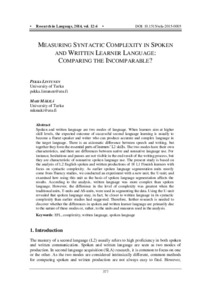Measuring Syntactic Complexity in Spoken and Written Learner Language: Comparing the Incomparable?
Lintunen Pekka; Mäkilä Mari
https://urn.fi/URN:NBN:fi-fe2021042717427
Tiivistelmä
Spoken and written
language are two modes of language. When learners aim at higher skill
levels, the expected outcome of successful second language learning is
usually to become a fluent speaker and writer who can produce accurate
and complex language in the target language. There is an axiomatic
difference between speech and writing, but together they form the
essential parts of learners’ L2 skills. The two modes have their own
characteristics, and there are differences between native and nonnative
language use. For instance, hesitations and pauses are not visible in
the end result of the writing process, but they are characteristic of
nonnative spoken language use. The present study is based on the
analysis of L2 English spoken and written productions of 18 L1 Finnish
learners with focus on syntactic complexity. As earlier spoken language
segmentation units mostly come from fluency studies, we conducted an
experiment with a new unit, the U-unit, and examined how using this unit
as the basis of spoken language segmentation affects the results.
According to the analysis, written language was more complex than spoken
language. However, the difference in the level of complexity was
greatest when the traditional units, T-units and AS-units, were used in
segmenting the data. Using the U-unit revealed that spoken language may,
in fact, be closer to written language in its syntactic complexity than
earlier studies had suggested. Therefore, further research is needed to
discover whether the differences in spoken and written learner language
are primarily due to the nature of these modes or, rather, to the units
and measures used in the analysis.
Kokoelmat
- Rinnakkaistallenteet [27094]
